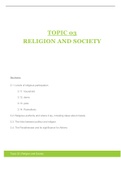TOPIC 03
RELIGION AND SOCIETY
Sections:
3.1: Levels of religious participation
3.11: household
3.12: deme
3.13: polis
3.14: Panhellenic
3.2: Religious authority and where it lay, including ideas about impiety
3.3: The links between politics and religion
3.4: The Panathenaea and its significance for Athens
Topic 03 | Religion and Society
,DEFINITIONS
Oikos
The family, the household or the home. An Oikos is made up of everybody who lives in one
premise. Usually made up of extended families- father, mother, sons, the wives of sons
(daughter-in-law joined the household of the husband), grandchildren, unmarried daughters,
household slaves, property (including livestock).
Amphidromia
A ceremonial feast celebrated on the fifth or seventh day after the birth of a child. It was a family
celebration (not a public one) at which the newly born baby was introduced to the family. The
would run around the hearth, and were welcomed with a small ceremony of walking around the
fire in a shower of dried fruits and nuts
Apotropaic
The quality of being able to avert evil influences or bad luck.
Deme
A village or district which was the smallest political constituency in the Athenian democratic
system. Smaller than a polis (more like a city).
Asebeia
The Greek word for impiety, which was something that people were accused of, rather than a
neutral way of describing actions and thoughts. This is what Socrates was accused of.
Miasma
The Greek word for pollution. This was a serious offence and dishonor/disrespect to the gods.
Individuals and their whole communities could be punished for it (e.g. Oedipus Rex). There were
various ways of being polluted- still birth, loss of foetus and abortions, physically dirty, not
honouring the gods, disrespecting ancestral laws of burial, disrespecting someone’s
right to asylum, safe refuge within a sanctuary, sex, being in the presence of a dead
body, murder, or entering the home of a woman who had just given birth
2
, Apobates Race
This was performed at the Panathenaea, whereby a charioteer drove a chariot while a hoplite
solider jumped off the moving chariot and raced alongside it, before jumping back on the moving
chariot. This displayed military skills of Athenian men.
HOUSEHOLD RELIGION
- Worshipped together, same deities, eldest free male citizen
- There were several different deities in the Oikos:
Zeus Ktesios- the acquisition of property and preservation and wealth, kept in a
storeroom, represented by a two-handled vase draped in a white woolen ribbon,
filled with seeds, water and olive oil (Sources: Isaeus- description of Ciron,
Aeschylus)
Zeus Herkeios- protected the enclosure of the house, statue stood in the
courtyard, around which the house was structured, protected the Oikos from the
inside from intruders, often depicted with a snake to ward off evil (Odysseus’ altar)
Apollo Agyeios- protected the house from the outside, by a statuette or even a
small pillar by the main door, either Apollo or a representation of Heracles thought
to avert evil
Hestia- every household had a central hearth, dedicated to Hesta, represents a
home for the family (Source: Homeric Hymn to Aphrodite- central member of the
house)
The Herm- Each household had a Herme (a statue of Hermes with an especially
pronounced phallus that presided over fertility of flocks) which stood as halfway
markers on roads and as protective symbols outside houses
Family Tombs:
- Tended to by the father of the household
- Each year, offerings of garlands and libations of milk and honey were offered at the
graveside in the name of the deceased
- The most tangible and lasting remnant of their memory
- Source: Isaeus- importance of a legacy
Women:
- Limited political and legal rights and in Athens were not considered full citizens
- Source: Demonsthenes- behavior of women
3




